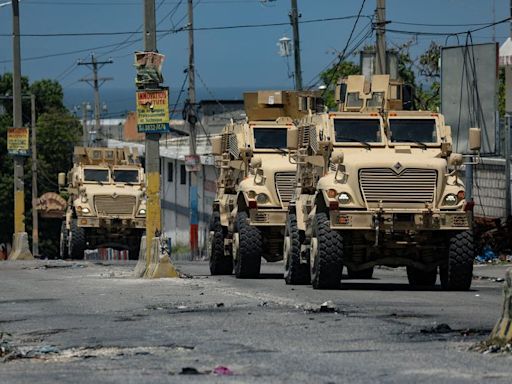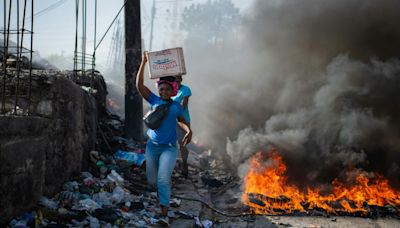Search results
Haiti, [b] officially the Republic of Haiti, [c] [d] is a country on the island of Hispaniola in the Caribbean Sea, east of Cuba and Jamaica, and south of The Bahamas. It occupies the western three-eighths of the island, which it shares with the Dominican Republic.
- Overview
- Land
- Relief and drainage
- Soils
Haiti, country in the Caribbean Sea that includes the western third of the island of Hispaniola and such smaller islands as Gonâve, Tortue (Tortuga), Grande Caye, and Vache. The capital is Port-au-Prince.
Haiti, whose population is almost entirely descended from African slaves, won independence from France in 1804, making it the second country in the Americas, after the United States, to free itself from colonial rule. Over the centuries, however, economic, political, and social difficulties as well as a number of natural disasters have beset Haiti with chronic poverty and other serious problems.
Haiti is bordered to the east by the Dominican Republic, which covers the rest of Hispaniola, to the south and west by the Caribbean, and to the north by the Atlantic Ocean. Cuba lies some 50 miles (80 km) west of Haiti’s northern peninsula, across the Windward Passage, a strait connecting the Atlantic to the Caribbean. Jamaica is some 120 miles (1...
The generally rugged topography of central and western Hispaniola is reflected in Haiti’s name, which derives from the indigenous Arawak place-name Ayti (“Mountainous Land”); about two-thirds of the total land area is above 1,600 feet (490 metres) in elevation. Haiti’s irregular coastline forms a long, slender peninsula in the south and a shorter one in the north, separated by the triangular-shaped Gulf of Gonâve. Within the gulf lies Gonâve Island, which has an area of approximately 290 square miles (750 square km). Haiti’s shores are generally rocky, rimmed with cliffs, and indented by a number of excellent natural harbours. The surrounding seas are renowned for their coral reefs. Plains, which are quite limited in extent, are the most productive agricultural lands and the most densely populated areas. Rivers are numerous but short, and most are not navigable.
Britannica Quiz
Which Country Is Larger? Quiz
The backbone of the island of Hispaniola consists of four major mountain ranges that extend from west to east. The most northerly range, known as the Cordillera Septentrional in the Dominican Republic, occurs in Haiti only on Tortue Island, off the northern coast. Tortue Island has an area of about 70 square miles (180 square km). In the 17th century it was a stronghold of privateers and pirates from various countries.
The second major range, Haiti’s Massif du Nord (“Northern Massif”), is a series of parallel chains known in the Dominican Republic as the Cordillera Central. It has an average elevation of some 4,000 feet (1,200 metres). The Citadel (Citadelle Laferrière), a fortress built by Haitian ruler Henry Christophe in the early 19th century, stands atop one of the peaks overlooking the city of Cap-Haïtien and the narrow coastal plain.
Special offer for students! Check out our special academic rate and excel this spring semester!
The soils in the mountains are thin and lose fertility quickly when cultivated. The lower hills are covered with red clays and loams. The alluvial soils of the plains and valleys are fertile but overcultivated, owing to high population densities in those areas. Deforestation has caused much soil erosion, and as much as one-third of Haiti’s land may...
Jun 19, 2023 · Haiti is a large mountainous country located in the north-central Caribbean; occupying the western third of the Island of Hispaniola in the Greater Antilles archipelago. It is positioned in the Northern and Western hemispheres of the Earth.
- Port-au-Prince
- Republic of Haiti
- 27,560.00 km 2
- 27,750.00 km 2
Sep 5, 2024 · Location. Caribbean, western one-third of the island of Hispaniola, between the Caribbean Sea and the North Atlantic Ocean, west of the Dominican Republic. Geographic coordinates. 19 00 N, 72 25 W.
Sep 5, 2024 · Background. In 1697, Spain ceded to the French the western third of the island of Hispaniola, which later became Haiti. The French colony, based on forestry and sugar-related industries, became one of the wealthiest in the Caribbean. Currently the poorest country in the Western Hemisphere, Haiti continues to experience bouts of political ...
Dec 22, 2021 · Location. Caribbean, western one-third of the island of Hispaniola, between the Caribbean Sea and the North Atlantic Ocean, west of the Dominican Republic. Geographic coordinates. 19 00 N, 72 25 W. Map references. Central America and the Caribbean. Area. total: 27,750 sq km. land: 27,560 sq km. water: 190 sq km. country comparison to the world: 147






